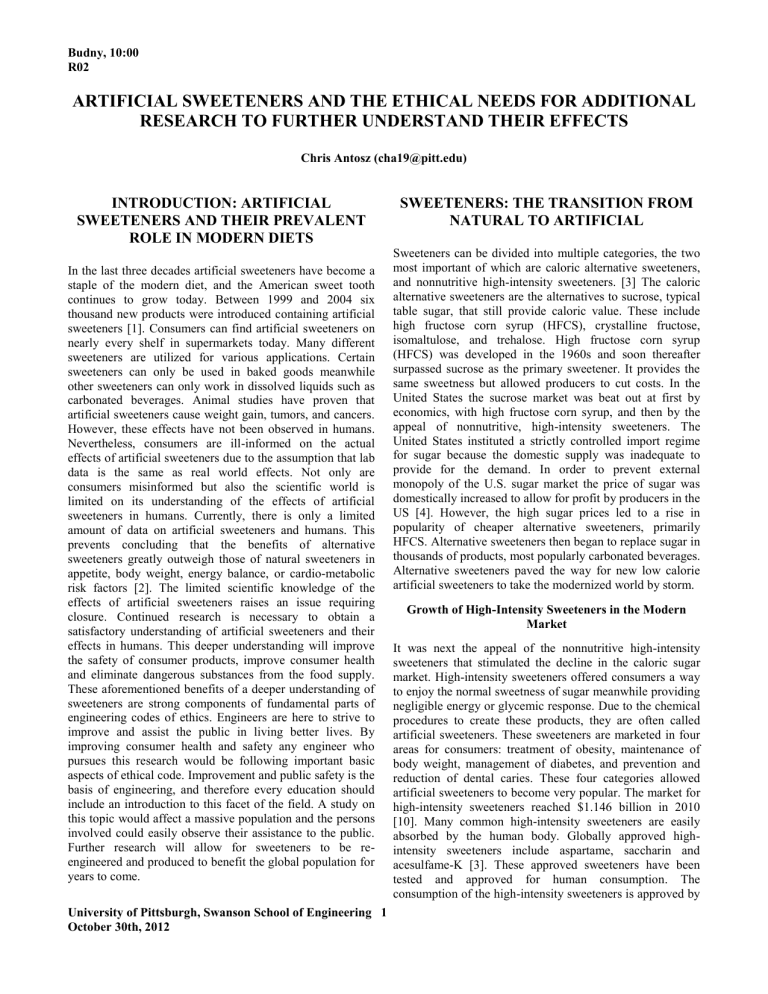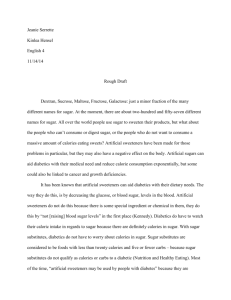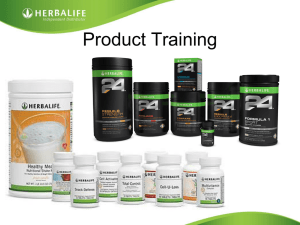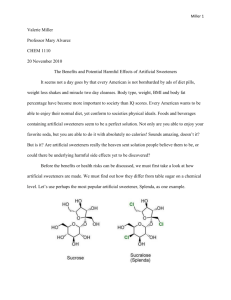artificial sweeteners and the ethical needs for additional research to

Budny, 10:00
R02
ARTIFICIAL SWEETENERS AND THE ETHICAL NEEDS FOR ADDITIONAL
RESEARCH TO FURTHER UNDERSTAND THEIR EFFECTS
Chris Antosz (cha19@pitt.edu)
INTRODUCTION: ARTIFICIAL
SWEETENERS AND THEIR PREVALENT
ROLE IN MODERN DIETS
In the last three decades artificial sweeteners have become a staple of the modern diet, and the American sweet tooth continues to grow today. Between 1999 and 2004 six thousand new products were introduced containing artificial sweeteners [1]. Consumers can find artificial sweeteners on nearly every shelf in supermarkets today. Many different sweeteners are utilized for various applications. Certain sweeteners can only be used in baked goods meanwhile other sweeteners can only work in dissolved liquids such as carbonated beverages. Animal studies have proven that artificial sweeteners cause weight gain, tumors, and cancers.
However, these effects have not been observed in humans.
Nevertheless, consumers are ill-informed on the actual effects of artificial sweeteners due to the assumption that lab data is the same as real world effects. Not only are consumers misinformed but also the scientific world is limited on its understanding of the effects of artificial sweeteners in humans. Currently, there is only a limited amount of data on artificial sweeteners and humans. This prevents concluding that the benefits of alternative sweeteners greatly outweigh those of natural sweeteners in appetite, body weight, energy balance, or cardio-metabolic risk factors [2]. The limited scientific knowledge of the effects of artificial sweeteners raises an issue requiring closure. Continued research is necessary to obtain a satisfactory understanding of artificial sweeteners and their effects in humans. This deeper understanding will improve the safety of consumer products, improve consumer health and eliminate dangerous substances from the food supply.
These aforementioned benefits of a deeper understanding of sweeteners are strong components of fundamental parts of engineering codes of ethics. Engineers are here to strive to improve and assist the public in living better lives. By improving consumer health and safety any engineer who pursues this research would be following important basic aspects of ethical code. Improvement and public safety is the basis of engineering, and therefore every education should include an introduction to this facet of the field. A study on this topic would affect a massive population and the persons involved could easily observe their assistance to the public.
Further research will allow for sweeteners to be reengineered and produced to benefit the global population for years to come.
SWEETENERS: THE TRANSITION FROM
NATURAL TO ARTIFICIAL
Sweeteners can be divided into multiple categories, the two most important of which are caloric alternative sweeteners, and nonnutritive high-intensity sweeteners. [3] The caloric alternative sweeteners are the alternatives to sucrose, typical table sugar, that still provide caloric value. These include high fructose corn syrup (HFCS), crystalline fructose, isomaltulose, and trehalose. High fructose corn syrup
(HFCS) was developed in the 1960s and soon thereafter surpassed sucrose as the primary sweetener. It provides the same sweetness but allowed producers to cut costs. In the
United States the sucrose market was beat out at first by economics, with high fructose corn syrup, and then by the appeal of nonnutritive, high-intensity sweeteners. The
United States instituted a strictly controlled import regime for sugar because the domestic supply was inadequate to provide for the demand. In order to prevent external monopoly of the U.S. sugar market the price of sugar was domestically increased to allow for profit by producers in the
US [4]. However, the high sugar prices led to a rise in popularity of cheaper alternative sweeteners, primarily
HFCS. Alternative sweeteners then began to replace sugar in thousands of products, most popularly carbonated beverages.
Alternative sweeteners paved the way for new low calorie artificial sweeteners to take the modernized world by storm.
Growth of High-Intensity Sweeteners in the Modern
Market
It was next the appeal of the nonnutritive high-intensity sweeteners that stimulated the decline in the caloric sugar market. High-intensity sweeteners offered consumers a way to enjoy the normal sweetness of sugar meanwhile providing negligible energy or glycemic response. Due to the chemical procedures to create these products, they are often called artificial sweeteners. These sweeteners are marketed in four areas for consumers: treatment of obesity, maintenance of body weight, management of diabetes, and prevention and reduction of dental caries. These four categories allowed artificial sweeteners to become very popular. The market for high-intensity sweeteners reached $1.146 billion in 2010
[10]. Many common high-intensity sweeteners are easily absorbed by the human body. Globally approved highintensity sweeteners include aspartame, saccharin and acesulfame-K [3]. These approved sweeteners have been tested and approved for human consumption. The consumption of the high-intensity sweeteners is approved by
University of Pittsburgh, Swanson School of Engineering
October 30th, 2012
1
Chris Antosz the Federal Drug Administration under restricted doses as the metabolic products of many sweeteners are toxic in high amounts [9]. This knowledge of possible toxic side effects led consumers to believe that artificial sweeteners were not a healthy alternative. In addition to the general public knowing limited information on artificial sweeteners, even professional dietitians don’t fully understand them. In a recent study by Taylor Rickrode, it was revealed that numerous Registered Dietitians hold opposing stances on the recommendation of artificial sweeteners in prescribed diets
[5]. It seems that the professional dietitians don’t understand the effects of artificial sweeteners enough to universally recommend them to patients. Therefore, based on the combination of professional and unprofessional lack of knowledge with artificial sweetener safety it is only obvious that further investigation is required. It seems little is known about the artificial sweeteners and for all we currently know, we could be poisoning ourselves.
SKEPTICISIM FROM YOUTH FUELED MY
INTEREST IN ARTIFICIAL SWEETENERS
I was raised in a time when the use of artificial sweeteners was on the rise and it surrounded me with foods and drinks full of artificial sweeteners. Preserving calories seemed to be an important goal of my parents when making choices between natural and alternatives sweeteners in the supermarket. The fridge was always stocked with diet beverages and low calorie alternatives. My family members would frequently state their opinion that aspartame was dangerous and should not be consumed by children. It was a rarity to find a regular non-diet beverage in my house.
Therefore, I was raised on aspartame and as time went by my perception of alternative sweeteners turned skeptical and
I doubted any benefits existed. The concept that something perceived so dangerous yet so universally used made me curious as to what this product actually was. The question that stuck in my mind was “Why would something so bad be government approved?” and I wanted to answer it as soon as possible. As I’ve read in current research, there still seems to be gaps in the knowledge we hold about sweeteners, and I strive to fill those gaps with further research.
ETHICAL SUPPORT FOR MY POSITION
TO FURTHER RESEARCH
Professional engineers strive to maintain a high standard of performance by following specific guidelines. Such guidelines are popularly called a code of ethics and are present in nearly every discipline in today’s professional fields. The National Society of Professional Engineers holds a Code of Ethics for Engineers and it is expected of engineering members to follow such guidelines. A professional obligation in this Code of Ethics is that
“Engineers shall at all times strive to serve the public interest.” [11]. This statement applies very well to the position that artificial sweeteners must be further researched.
When the knowledge of sweeteners varies so greatly between the professionals it can be only assumed the public knows even less. Therefore, it is in the public interest to understand the products that they seemingly cannot avoid in their daily lives. Another obligation in the code of ethics is that “Engineers are encouraged to extend public knowledge and appreciation of engineering and its achievements.” This further emphasizes that engineers have an ethical obligation to research artificial sweeteners due to multiple criteria being met. In addition to general codes of ethics specific fields can further accent the obligations that engineers hold.
THE ROLE OF CHEMICAL ENGINEERS IN
MAINTAINING PUBLIC SAFETY
Chemical engineers deal with substances that can include consumer products and the relationship between engineering research and public safety can easily be tied together under the code of ethics. A fundamental canon principal in the
American Institute of Chemical Engineers’ Code of Ethics is that “Members shall hold paramount the safety, health and welfare of the public and protect the environment in performance of their professional duties.” [12]. As represented earlier with poor professional knowledge of sweeteners it must be realized that public safety, health and welfare are currently in danger. This Code of Ethics statement is an integral part of my position emphasizing further research in the sweetener field. Should chemical engineers strive to be the best they can be, and desire to improve the world, it is necessary that they protect the safety and health of the public. Chemical engineers have no reason to not follow through with artificial sweetener research when it is obvious public safety is on the line. When deciding on whether or not it is worth it to be devoting time and money towards this research it need only be realized that artificial sweetener research will go towards the improvement of public safety and health. This realization trumps any argument because an engineer cannot be rationalized away from protecting the safety of the public. Therefore, the chemical engineers following the code of ethics presented by the American Institute of Chemical Engineers are obligated to partake in further research. Also, further research should be a primary priority for engineers when a product presents beneficial uses and alternatively risks to its users as artificial sweeteners provide.
HEALTH BENEFITS OF UTILIZING
ARTIFICIAL SWEETENERS OPPOSED TO
THEIR CALORIC COUNTERPARTS
Artificial sweeteners can play an important role in the maintenance of a healthy mouth. Dental caries are bacterial
2
Chris Antosz infections that destruct the hard tissue of tooth enamel, resulting in cavities or tooth decay. Diets with high amounts of sugar assist in the fueling of the bacterial growth [8].
However, sugar substitutes such as artificial sweeteners do not get absorbed and utilized by the bacteria [9]. Therefore, a diet that can incorporate artificial sweeteners can benefit the dental health of the user. This is, of course, no substitute for a normal dental regime but represents a benefit of artificial sweeteners [6]. What is important to the ethical pursuit of further research is that artificial sweeteners are beneficial and need not disappear because they are too dangerous. Further research can keep them in use and allow for continued dental benefits. In addition to dental health, artificial sweeteners can provide physical benefits that allow for a normal life for those afflicted by physical diseases.
Alternative Sweeteners Allow for Diabetics to Enjoy
Sweetened Food with Fewer Worries
Diabetics depend on artificial sweeteners to fulfill a tasteful diet and most importantly to maintain healthy blood-sugar levels. The high intake of sugars such as fructose and sucrose are attributed to the rise in global obesity, type-2 diabetes and cardiovascular problems [7]. The easiest way to lose weight and effectively become healthy is to limit sugar intake altogether. However, with the prevalence of sugar in food products today it is hard to avoid the sweets. Therefore, artificial sweeteners present a non-caloric alternative to sugar that can be utilized by diabetics and those who are pursuing for weight management through caloric restrictions.
A study compared a sucrose-rich diet to an artificialsweetener diet in overweight subjects for ten weeks. It concluded that the sucrose-rich diet resulted in significantly higher levels of glycaemia, insulinemia and lipidemia [7].
The short term results showing poor glucose, insulin and fat levels in the blood with the sucrose diet prove the positive potential for an artificial sweetener regimen. These results confirm that artificial sweeteners have beneficial potential despite having many unknown effects.
THE CHEMICAL UNKNOWNS OF HIGH-
POTENCY SWEETENERS
Susan Schiffman presents numerous aspects of artificial sweeteners about which little is known. In general she includes gaps on their pharmacokinetics (absorption, distribution, metabolism, and excretion), their membrane transport, their potential for drug interactions and their impact on appetite and body weight regulation [10]. These unknowns contain the pathways that would tell us whether or not the drug is dangerous. Sweetener transport and absorption are important to understanding the effects in humans. She emphasizes the need for further research to acquire a deeper understanding of artificial sweeteners. The proposal by Ms. Schiffman combined with the limited knowledge represented in Ms. Rickrode’s research is enough evidence to me that not enough is known about artificial sweeteners.
EDUCATIONAL POSSIBILITIES OF
UNDERSTANDING ETHICAL QUALITIES
Researching a position topic and further linking it to the ethical codes of engineers is the beginning of a sound education for the modern engineer. By getting acclimated with the reasons for holding positions on issues so early in an education engineering students can graduate prepared to tackle issues like mature engineers. It was seen that the use of degree projects, which can be compared to position papers as they both relate to field interests, increased chemical engineering efficacy and improved the student’s education [13]. Providing students with the perspectives their professional superiors hold in the field, through position papers, gives students the opportunity to think like engineers.
CONCLUSION: THE TRANSITION TO
ARTIFICIAL SWEETENERS AND THE
NEED FOR AN UNDERSTANDING
The artificial sweeteners that are prevalent in everyday food and drinks in the modern world are not fully understood but are important and need to continue to be improved. Through the understanding of ethical guidelines for engineers it can be easily seen that further research in artificial sweeteners is ethically supported. When artificial sweeteners are no longer misunderstood the world can rejoice in that engineers accomplished their primary goal, improving lives. Code of ethics are powerful tools that are very useful for influencing the conduct of engineers resulting in beneficial change.
Integrating this ethical value in engineers is also important as this allows the code to be followed without strict observation. Research into the ethical values of engineers is a very important step in the education of young engineers.
This ethical research affirms values that will later be used to solve real world problems. Engineers that learn ethics earlier in their education, through assignments like this, will allow the world to improve.
REFERENCES
[1] Q. Yang. (2010). “Gain weight by “going diet?”
Artificial sweeteners and the neurobiology of sugar cravings.” Yale Journal of Biology and Medicine. (Online
Article). http://www.ncbi.nlm.nih.gov/pmc/articles/PMC2892765/
[2] C. Gardner, J. Wylie-Rosett, S. Gidding, et al. (2012).
“Nonnutritive Sweeteners: Current Use and Health
Perspectives: A Scientific Statement from the American
3
Chris Antosz
Heart Association and the American Diabetes Association.”
Diabetes Care. (Online Article). DOI:10.2337/dc12-
[3] T. Varzakas, A. Labropoulos, S. Anestis. (2012).
“Sweeteners in General.” Sweeteners: Nutritional Aspects,
Applications, and Production Technology . London, GBR:
CRC Press. (Print book). pp. 1-9
[4] 9002W. Davey. (2009). “The Soft Drinks Case: The
WTO and Regional Agreements.” World Trade Review.
(Online Article). DOI:10.1017/S1474745608004151
[5] T. Rickrode. (2011). Artificial Sweeteners: Examining
Current Recommendations, Practices and Opinions of
Registered Dietitians . (Doctoral Dissertation). Retrieved from ProQuest®. (1499296)
[6] M. Roberts, T. Wright. (2012). “Nonnutritive, Low
Caloric Substitutes for Food Sugars: Clinical Implications for Addressing the Incidence of Dental Caries and
Overweight/Obesity.” International Journal of Dentistry .
(Online Article). DOI: 10.1155/2012/625701
[7] A. Raben, B. Moller, A. Flint, et al. (2011). “Increased postprandial glycaemia, insulinemia, and lipidemia after 10 weeks’ sucrose-rich diet compared to an artificially sweetened diet: a randomised controlled trial.” Food &
Nutrition Research 2011 . (Online Article). DOI:
10.3402/fnr.v55i0.5961
[8] T. Varzakas, A. Labropoulos, S. Anestis. (2012).
“Nutritional and Health Aspects of Sweeteners.”
Sweeteners: Nutritional Aspects, Applications, and
Production Technology. London, GBR: CRC Press. (Print book). pp. 329-355
[9] K. Tandel. (2011). “Sugar substitutes: Health controversy over perceived benefits.” Journal of
Pharmacology & Pharmacotherapeutics. (Online article).
DOI: 10.4103/0976-500X.85936
[10] S. Schiffman. (2012). “Rationale for Further Medical and Health Research on High-Potency Sweeteners.”
Advanced Access. (Online Article). DOI:
10.1093/chemse/bjs053
[11] National Society of Professional Engineers. (2007).
“Code of Ethics for Engineers.”
[12] American Institute of Chemical Engineers. “Code of
Professional Ethics.”
[13] G. Ragusa. (2012). “The impact of focused degree projects in chemical engineering education on students’ research performance, retention, and efficacy.” Education for Chemical Engineers . (Online Article). DOI:
10.1016/j.ece.2012.03.001
ACKNOWLEDGMENTS
I would like to thank my parents for inspiration with the topic as without them I would never have grown addicted to
Diet Dr. Pepper and would not have this topic. Last but not least I would like to thank Nickolas Holder for his continued moral support throughout the writing of this paper. I repetitively ran into blocks and got flustered and frustrated but he kept me going.
4



